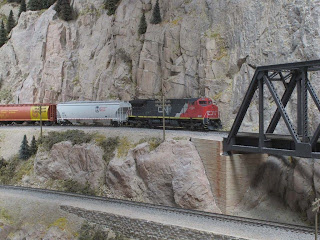 |
| 6027 still racks up the miles on the M & M Sub. |
Back in the late 1980s, when I returned to the hobby of model railroading, there weren't a lot of choices for locomotives for someone who wanted to model CP Rail.
Back then, pretty much the only quality affordable locomotives available in CP Rail livery were made by Athearn, which offered the SD40-2, GP38-2, SW7 (cow and calf) and F7 (A and B units) in its blue box line.
 |
| 6027, new in the box. Today this is considered a "vintage" locomotive! |
Of the four models, the SD40-2 was the most needed. At one time CP Rail owned 484 of these units, the third-most after Burlington Northern and Union Pacific in terms of the number of SD40-2s purchased by any North American railway. Any modeller hoping to do a halfways-decent job of replicating the prototype needed lots of those units.
Athearn offered the SD40-2 in two numbers: 6027 (with MultiMark and without) and 5415 (in Twin Flags scheme). I ended up with four (with MultiMark and without) and one (Twin Flags) on my roster--three of them re-numbered. (Plus others in ex-KCS, Union Pacific, SOO and primer schemes.)
 |
| The prototype; credit photo to Bill Sanderson. |
Of the two units, the 6027 seems to be the most ubiquitous; anyone who modelled CP Rail had one.
The prototype was built in 1982. Surprisingly, it is still on the CPR's roster today. In fact, it is due for a serious reconditioning at Progress Rail, which will turn it and 20 other SD40-2 units into SD30C ECO locomotives. The units are being rebuilt from SD40-2 cores and frames and powered by a new 12 cylinder 3000 hp 12-710G3F engine. When completed, the units will meet Tier 0+ U.S. emissions standards.
When finished, good old 6027 won't look like its former self--it will have a new fuel tank, cab and flared raditatiors ( to meet Tier 0+ requirements). It also won't be 6027 anymore; the rebuilt units will be renumbered into the 5000 series when released.
 |
| When rebuilt, 6027 will look like this. |
So, farewell old 6027 and welcome to the new 6027 in the real world. Since in my modelling world it's always the early 1990s, the old 6027 will continue to soldier on, moving tonnage on the Manitoba & Minnesota Sub.
P.S. By 2020, the CPR expects to be the largest operator of EMD's ECO line of locomotives, with nearly 500 locomotives being rebuilt over the next eight years.

















































